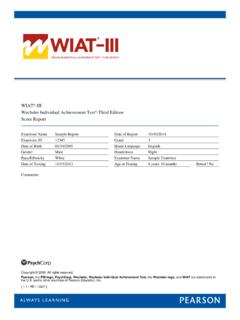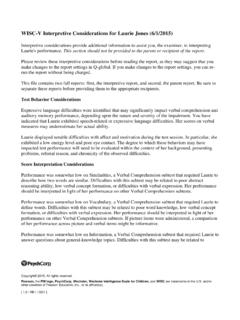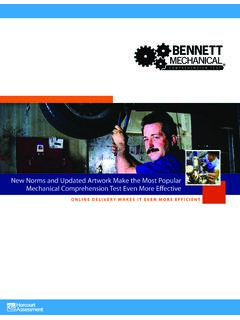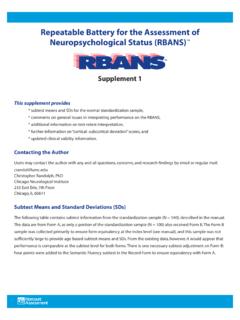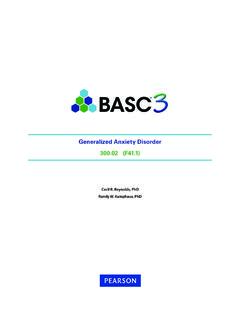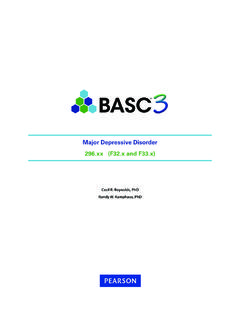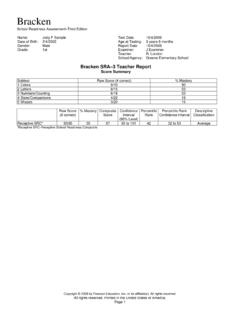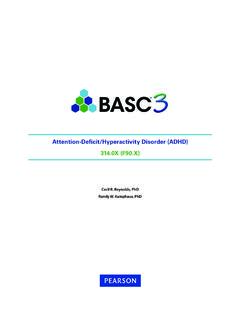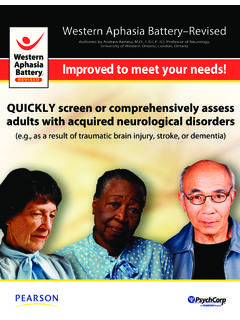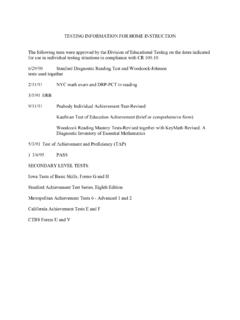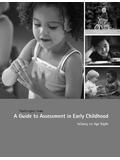Transcription of Q-interactive Special Group Studies: The WISC-V …
1 Q-interactive Special Group studies : The WISC V and Children with Intellectual Giftedness and Intellectual Disability Q-interactive Technical Report 9. Susan Engi Raiford, PhD. James Holdnack, PhD. Lisa Drozdick, PhD. Ou Zhang, PhD. November, 2014. Copyright 2014 NCS Pearson, Inc. All rights reserved. Page 1. Pearson, Q interactive , and WISC are trademarks in the and/or other countries, of Pearson Education, Inc., or its affiliate(s). Introduction Q-interactive , a Pearson digital system for individually administered tests, is designed to make assessment more convenient and accurate, provide practitioners with easy access to a large number of tests, and support new types of tests that cannot be administered or scored without computer assistance. With Q-interactive , the examiner and examinee use wireless tablets that are synched with each other, enabling the examiner to read administration instructions, time and capture response information (including audio recording), and view and control the examinee's tablet.
2 The examinee tablet displays visual stimuli and captures touch responses. In the initial phase of adapting tests to the Q-interactive platform, the goal has been to maintain raw-score equivalence between standard (paper) and digital administration and scoring formats. This goal is facilitated to the extent that the effects of examinee tablet interaction and assessment in the digital environment can be minimized, and that response capture and scoring remains accurate. If equivalence is demonstrated, then the norms, reliability, and validity information gathered for the paper format can be applied to Q-interactive results. To date, equivalence has been evaluated and demonstrated for the Wechsler Intelligence Scale for Children Fourth Edition (WISC IV; Wechsler, 2003), the Wechsler Intelligence Scale for Children Fifth Edition (WISC V;. Wechsler, 2014), the Wechsler Adult Intelligence Scale Fourth Edition (WAIS IV; Wechsler, 2008), and a number of other cognitive, achievement, and language tests (Daniel, 2012a, 2012b, 2012c, 2013a, 2013b, 2013c; Daniel, Wahlstrom, & Zhang, 2014; Daniel, Wahlstrom, & Zhou, 2014).
3 As noted in the WISC V equivalence study technical report (Daniel, Wahlstrom, & Zhang, 2014), the Q-interactive equivalence studies have used samples of nonclinical examinees to maintain focus on estimating the presence and size of any effects of the digital administration format. These studies were designed to show equivalence of the normative data, and therefore focused on non- clinical cases to establish that the paper normative data apply equally well to the test when it is administered in a digital format. After normative equivalence was established, focus could shift to providing evidence of performance consistency in clinical conditions and Special groups of interest who were administered the test in a digital format. Given that the impact of computer-assisted administration on individuals with particular clinical conditions is not known, further research was required to demonstrate whether similar results would be obtained when varying the administration format from paper to digital for Special populations or with various clinical conditions.
4 Understanding the interaction of administration format for examinees with clinical conditions or from other Special populations ( , gifted and talented) is ultimately of importance for clinical applications of Q-interactive . In the Standards for Educational and Psychological Testing (Standards; American Educational Research Association, American Psychological Association, & National Council on Measurement in Education, 2014), Standard describes collecting and presenting evidence of how a target construct is or is not altered by allowable variations in administration conditions, such as paper and digital formats of the same test. Accordingly, this technical report describes the results of two Special Group studies of children tested on the Copyright 2014 NCS Pearson, Inc. All rights reserved. Page 2. Pearson, Q interactive , and WISC are trademarks in the and/or other countries, of Pearson Education, Inc.
5 , or its affiliate(s). WISC V digital version on Q-interactive : Children identified as intellectually gifted and children with intellectual disability. Other Special Group study results are forthcoming in future reports. The WISC V equivalence study found there was virtually no effect of format by ability level. These results are relevant to the current work, as the Special groups studied in this report ( , intellectually gifted and intellectual disability) represent the extremes of high and low ability, respectively. Children Identified as Intellectually Gifted Children identified as intellectually gifted demonstrate high performance on measures of intellectual functioning, cognitive flexibility, creativity, and/or other specific cognitive ability areas (Geake, 2008;. Koziol, Budding, & Chidekel, 2010; Munro, 2013; Vald s, Vera, & Carlos, 2013). They obtain mean cognitive ability scores that are significantly higher than children in the general population.
6 Moreover, these children tend to obtain higher scores on all composite measures in comparison to same-age peers (Rimm, Gilman, & Silverman, 2008; Rowe, Kingsley, & Thompson, 2010;. Sweetland, Reina, & Tatti, 2006; Wechsler, 2002, 2003). Although gifted individuals perform well on all of the traditional Wechsler intelligence scale subtests, some gifted individuals show unusually large discrepancies between their verbal and nonverbal scores (Sweetland et al., 2006). Children with intellectual giftedness typically show particular strengths in the areas of verbal comprehension, visual spatial ability, and fluid reasoning. Although their working memory and processing speed performance is generally higher than in the general population (Elliot, 2007; Kaufman & Kaufman, 2004; Wechsler, 2003, 2008, 2012, 2014), it typically is lower than their performance on verbal comprehension, visual spatial, and fluid reasoning measures (Raiford, Weiss, Rolfhus, & Coalson, 2005; Rimm et al.)
7 , 2008; Rowe et al., 2010). Because of the evidence that children who are intellectually gifted show intra-individual weaknesses in the areas of working memory and processing speed, some have advocated that both the WISC IV Full Scale IQ and the WISC IV General Ability Index are useful for gifted admissions evaluations if cognitive ability scores are used as a criteria (Rimm et al., 2008). The Full Scale IQ, however, appears to be a better predictor of academic achievement, including reading comprehension and math, in children identified as intellectually gifted (Rowe, Miller, Ebenstein, & Thompson, 2012). Among the WISC IV index scores, the Verbal Comprehension Index and the Working Memory Index are also strong predictors of achievement in children identified as intellectually gifted (Rowe et al., 2010). The WISC V Technical and Interpretive Manual indicates that both the FSIQ and the GAI can be useful for evaluation of intellectual giftedness (Wechsler, 2014).
8 There are a number of factors that can affect the results obtained in studies of intellectual giftedness. First, various intellectual ability measures produce highly correlated, yet different, estimates of cognitive ability. Second, the criteria for identifying children as intellectually gifted vary from site to site, as well as from state to state (Pfeiffer, 2013). Third, children enrolled in gifted and talented programs are occasionally admitted on the basis of achievement scores, and high achievement scores are not always associated with high intellectual ability. Because of these factors, the results of studies with children identified as intellectually gifted vary slightly across samples. To date, there are few studies of digital assessment conducted with intellectually gifted children;. however, in general, the use of digital technology in assessment and instruction is viewed positively by gifted children, and a synthesis of the literature indicates that digital technology can be utilized Copyright 2014 NCS Pearson, Inc.
9 All rights reserved. Page 3. Pearson, Q interactive , and WISC are trademarks in the and/or other countries, of Pearson Education, Inc., or its affiliate(s). with gifted individuals to produce comparable or superior assessment and instruction results relative to traditional paper delivery (Periathiruvadi & Rinn, 2012). One study investigated use of a fluid reasoning task, with both paper and digital formats, for assessing intellectual giftedness (Preckel &. Thiemann, 2003). Results suggested that valid and reliable data were obtained using both formats. A direct comparison of the results from the two format conditions was not considered appropriate, however, because administration of the digital format was not proctored. Furthermore, the digital format had a much higher dropout rate than the paper format, so motivation may have been a factor for those who completed it.
10 Other studies involving the assessment of gifted children for related constructs, such as strategic thinking (Steiner, 2006) and self-regulation (Calero, Garc a-Mart n, Jim nez, Kaz n, & Araque, 2007), indicate that assessment in paper or digital formats with gifted children produced comparable results. Children with Intellectual Disability According to criteria specified in the Diagnostic and Statistical Manual of Mental Disorders, Fifth Edition (DSM 5; American Psychiatric Association, 2013), a child diagnosed with intellectual disability must demonstrate deficits in both intellectual functions and adaptive functioning in at least one activity of daily living across multiple settings. The deficits must be confirmed by both clinical assessment and individual standardized intellectual testing, and have an onset in the developmental period. According to the American Association on Intellectual and Developmental Disabilities (AAIDD), intellectual disability originates before the age of 18 and is characterized by significant limitations in both intellectual functioning and adaptive behavior expressed as conceptual, social, and practical skills (AAIDD, 2010).
